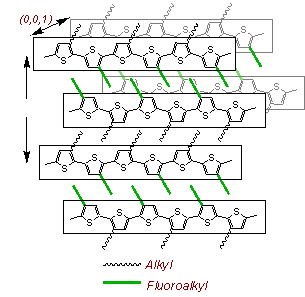|
RESEARCH
self-assembling polyphilic polymers |
|
|
GIT > Chemistry and Biochemistry > Collard Faculty Page > Research |
|
|
Self-assembling Polyphilic Conjugated Polymers Control of the orientation of the backbone of conjugated polymers is key to the development of new semiconducting organic polymers for use in the next generation of LEDs, FETs and sensors. Nature uses a variety of non-covalent forces, hydrophobicity and amphiphilicity to organize molecules into complex architectures. Taking clues from Nature, we are preparing amphiphilic and polyphilic conjugated polymers to prepare materials that self-organize and self-orient. For example, a conjugated polythiophene with alternating alkyl and perfluoroalkyl side chains forms a highly ordered architecture by virtue of the three distinct parts of the structure (arene backbone, fluorocarbon, hydrocarbon). Supported by award 0347832 from the National Science Foundation (Division of Material Research)
Representative publications
“Synthesis, Properties, and Tunable Supramolecular Architecture of Regioregular Poly(3-alkylthiophene)s with Alternating Alkyl and Semifluoroalkyl Substituents”, B. Wang, S. Watt, M. Hong, B. Domercq, R. Sun, B. Kippelen, D.M. Collard, Macromolecules 2008, 41, 5156.
"Tuning the Electronic Structure of Conjugated Polymers with Fluoroalkyl Substitution: Alternating Alkyl/Perfluoroalkyl-Substituted Polythiophene", L. Li, D.M. Collard, Macromolecules 2005, 38, 372-378.
"Tuning the Electronic Structure and Solubility of Conjugated Polymers with Perfluoroalkyl Substituents: Poly(3-perfluorooctyl)thiophene: The First scCO2-soluble Conjugated Polymer", L. Li, K.E. Counts, S. Kurasawa, A.S. Teja, D.M. Collard, Advanced Materials 2004, 16, 180.
|
|
|
Professor David Collard |
Office: 2100J Molecular Science and Engineering
|
